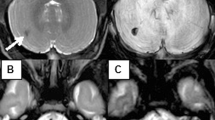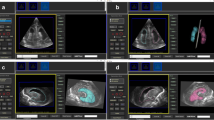Abstract
The aim of this study is to evaluate cerebellar growth of preterm infants with intraventricular hemorrhage. Vermis height (VH) and transverse cerebellar diameter (TCD) were measured by cranial ultrasound in 18 preterm infants (26–30 weeks) with intraventricular hemorrhage (IVH) at first 3 days of life and at term equivalent age (TEA). IVH was diagnosed by ultrasonography and scaled in accordance with the definitions by Papile et al. Measurements were compared with 18 preterm (26–30 weeks) infants without IVH. Both VH and TCD of preterm infants with IVH were significantly lower than those of preterm ones without IVH at TEA (p < 0.001). No significant difference was found for head circumference (p = 0.158) and weight (p = 0.092). In subgroup analysis, preterm infants with grades 3–4 IVH had significantly lower TCD (p = 0.008) and head circumference (p = 0.033) than the ones with grades 1–2 IVH. However, VH (p = 0.102) and weight (p = 0.480) did not show any difference between these subgroups. IVH may have a significant impact on cerebellar growth on preterm infants at TEA, specially those with a severe IVH. TCD is affected more than VH.
Similar content being viewed by others
References
Adams-Chapman I. Insults to the developing brain and impact on neurodevelopmental outcome. J Commun Disord. 2009;42:256–62.
Volpe JJ. Brain injury in premature infants: a complex amalgam of destructive and developmental disturbances. Lancet Neurol. 2009;8:110–24.
Volpe JJ. Intracranial hemorrhage germinal matrix-intraventricular of the premature infant. In: Volpe JJ, editor. Neurology of the newborn. 4th ed. Philadelphia: Saunders; 2001. p. 428–93.
Chang CH, Chang FM, Yu CH, Ko HC, Chen HY. Assesment of fetal cerebellar volume using three-dimensional ultrasound. Ultrasound Med Biol. 2000;26:981–8.
Tam EWY, Ferriero DM, Xu D, Berman JI, Vigneron DB, Barkovich AJ, et al. Cerebellar development in the preterm neonate: effect of supratentorial brain injury. Pediatr Res. 2009;66:102–6.
Tam EWY, Miller SP, Studholme C, Chau V, Glidden D, Poskitt KJ, et al. Differential effects of intraventricular hemorrhage and white matter injury on preterm cerebellar growth. J Pediatr. 2011;158:366–71.
Graça AM, Geraldo AF, Cardoso K, Cowan FM. Preterm cerebellum at term age: ultrasound measurements are not different from infants born at term. Pediatr Res. 2013;74(6):698–704.
Ovali F. Intrauterin growth curves for Turkish infants born between 25 and 42 weeks of gestation. J Trop Pediatr. 2003;49:381–3.
Papile LA, Burstein J, Burstein R, Koffler H. Incidence and evolution of subependymal and intraventricular hemorrhage: a study of infants with birth weights less than 1.500 gm. J Pediatr. 1978;92:529–34.
Imamoglu EY, Gursoy T, Ovali F, Hayran M, Karatekin G. Nomograms of cerebellar vermis height and transverse cerebellar diameter in appropriate-for-gestational-age neonates. Early Hum Dev. 2013;89:919–23.
Brennan P, Silman A. Statistical methods for assessing observer variability in clinical measures. BMJ. 1992;304:1491–4.
Srinivasan L, Allsop J, Counsell SJ, Boardman JP, Edwards AD, Rutherford M. Smaller cerebellar volumes in very preterm infants at term-equivalent age are associated with the presence of supratentorial lesions. Am J Neuroradiol. 2006;27:573–9.
Limperopoulos C, Soul JS, Gauvreau K, Huppi PS, Warfield SK, Bassan H, et al. Late gestation cerebellar growth is rapid and impeded by premature birth. Pediatrics. 2005;115:688–95.
Sancak S, Gursoy T, Imamoglu EY, Karatekin G, Ovali F. Effect of prematurity on cerebellar growth. J Child Neurol. 2015.
Allin MPG, Salaria S, Nosarti C, Wyatt J, Rifkin L, Murray RM. Vermis and lateral lobes of the cerebellum in adolescents born very preterm. Neuroreport. 2005;16:1821–4.
Schmahmann JD, Sherman JC. The cerebellar cognitive affective syndrome. Brain. 1998;121(4):561–79. 31.
Schmahmann JD, Weilburg JB, Sherman JC. The neuropsychiatry of the cerebellum—insights from the clinic. Cerebellum. 2007;6:254–67.
Baillieux H, De Smet HJ, Paquier PF, De Deyn PP, Mariën P. Cerebellar cognition: insights into the bottom of the brain. Clin Neurol Neurosurg. 2008;110(8):763–73.
Tavano A, Grasso R, Gagliardi C, Triulzi F, Bresolin N, Fabbro F, et al. Disorders of cognitive and affective development in cerebellar malformations. Brain. 2007;130:2646–60.
Limperopoulos C, Bassan H, Gauvreau K, Robertson Jr RL, Sullivan NR, Benson CB, et al. Does cerebellar injury in premature infants contribute to the high prevalence of long-term cognitive, learning, and behavioral disability in survivors? Pediatrics. 2007;120:584–93.
Shah DK, Anderson PJ, Carlin JB, Pavlovic M, Howard K, Thompson DK, et al. Reduction in cerebellar volumes in preterm infants: relationship to white matter injury and neurodevelopmen at 2 years of age. Pediatr Res. 2006;60:97–102.
Lind A, Parkkola R, Lehtonen L, Munck P, Maunu J, Lapinleimu H, et al. Associations between regional brain volumes at term-equivalent age and development at 2 years of age in preterm children. Pediatr Radiol. 2011;41:953–61.
Volpe JJ. Cerebellum and the premature infant: rapidly developing, vulnerable, clinically important. J Child Neurol. 2009;24:1085–104.
Rakic P, Sidman RL. Histogenesis of cortical layers in human cerebellum, particularly the lamina dissecans. J Comp Neurol. 1970;139:473–500.
Haldipur P, Bharti U, Alberti C, Sarkar C, Gulati G, Iyengar S, et al. Preterm delivery disrupts the developmental program of the cerebellum. PLoS One. 2011;6:e23449.
Corrales JD, Rocco GL, Blaess S, Guo Q, Joyner AL. Spatial pattern of sonic hedgehog signaling through Gli genes during cerebellum development. Development. 2004;131:5581–90.
Messerschmidt A, Brugger PC, Boltshauser E, Zoder G, Sterniste W, Birnbacher R, et al. Disruption of cerebellar development: potential complication of extreme prematurity. AJNR Am J Neuroradiol. 2005;26:1659–67.
Koeppen AH, Michael SC, Li D, Chen Z, Cusack MJ, Gibson WM, et al. The pathology of superficial siderosis of the central nervous system. Acta Neuropathol. 2008;116(4):371–82.
Soto-Ares G, Vinchon M, Delmaire C, Abecidan E, Dhellemes P, Pruvo JP. Cerebellar atrophy after severe traumatic head injury in children. Childs Nerv Syst. 2001;17:263–9.
Aronowski J, Zhao X. Molecular pathophysiology of cerebral hemorrhage: secondary brain injury. Stroke. 2011;42:1781–6.
Tam EW. Potential mechanisms of cerebellar hypoplasia in prematurity. Neuroradiology. 2013;55(2):41–6.
Biran V, Verney C, Ferriero DM. Perinatal cerebellar injury in human and animal models. Neurol Res Int. 2012. doi:10.1155/2012/858929.
Author information
Authors and Affiliations
Corresponding author
Ethics declarations
Written parental consent was obtained from the parents and local ethics committee approved the study protocol.
Funding
The research being reported in this publication was not supported by any sponsor.
Conflict of Interest
The authors declare that they have no competing interests.
Rights and permissions
About this article
Cite this article
Sancak, S., Gursoy, T., Karatekin, G. et al. Effect of Intraventricular Hemorrhage on Cerebellar Growth in Preterm Neonates. Cerebellum 16, 89–94 (2017). https://doi.org/10.1007/s12311-016-0766-0
Published:
Issue Date:
DOI: https://doi.org/10.1007/s12311-016-0766-0




